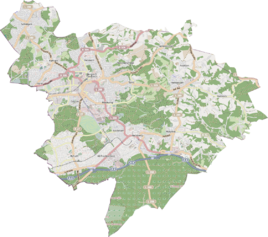Goat
|
Goat
City of Bergisch Gladbach
Coordinates: 50 ° 59 ′ 13 ″ N , 7 ° 5 ′ 42 ″ E
|
||
|---|---|---|
|
Location of Geisbock in Bergisch Gladbach |
||
Geisbock was a district in the Hand district of the city of Bergisch Gladbach in the Rheinisch-Bergisches Kreis . It now forms a closed settlement area with Duckterath , so that it is no longer perceived as an independent district.
Location and description
Geisbock was mainly located in the vicinity of today's houses Duckterather Weg 62 and 64. For a long time there was a breeding station for goats at Duckterather Weg 64. An earlier inn was named after the district.
history
Carl Friedrich von Wiebeking names the court on his charter of the Duchy of Berg in 1789 as Geisber . It shows that Geisbock was part of the Paffrath Honschaft in the parish of Paffrath at that time .
Under French administration between 1806 and 1813, the Porz office was dissolved and Geisbock was politically assigned to Mairie Gladbach in the canton of Bensberg . In 1816 the Prussians converted the Mairie to the mayor's office in Gladbach in the Mülheim am Rhein district . With the Rhenish City Code , Gladbach became a city in 1856, which was then given the addition of Bergisch in 1863 .
The place is recorded on the topographical survey of the Rhineland from 1824 and on the Prussian first survey of 1840 as a goat . From the Prussian new admission in 1892, he is regularly recorded as a goat on measuring table sheets .
| year | Residents | Residential
building |
category | Political / Church affiliation |
|---|---|---|---|---|
| 1822 | Yard | Mayor's office in Gladbach, Parish Paffrath (called Geisbach ) | ||
| 1830 | 8th | Yard | Mayor's office in Gladbach, parish of Paffrath | |
| 1845 | 21st | 3 | Yard | Gladbach mayor, Gronau parish |
| 1871 | 11 | 2 | Locality | City of Bergisch Gladbach / Mayor of Bergisch Gladbach |
| 1885 | 19th | 3 | Locality | City of Bergisch Gladbach / Mayor of Bergisch Gladbach |
| 1895 | 21st | 4th | Locality | City of Bergisch Gladbach / Mayor of Bergisch Gladbach |
| 1905 | 75 | 8th | Locality | City of Bergisch Gladbach / Mayor's Office Bergisch Gladbach, Catholic parish Bergisch Gladbach |
Individual evidence
- ^ Wilhelm Fabricius : Explanations for the Historical Atlas of the Rhine Province. Second volume: The map from 1789. Division and development of the territories from 1600 to 1794. Bonn 1898.
- ↑ Alexander A. Mützell: New topographical-statistical-geographical dictionary of the Prussian state . tape 1 . Karl August Künnel, Halle 1821.
- ↑ Friedrich von Restorff : Topographical-statistical description of the Royal Prussian Rhine Province , Nicolai, Berlin and Stettin 1830
- ↑ Overview of the components and list of all the localities and individually named properties of the government district of Cologne: by districts, mayor's offices and parishes, with information on the number of people and the residential buildings, as well as the Confessions, Jurisdictions, Military and former state conditions. / ed. from the Royal Government of Cologne [Cologne], [1845]
- ↑ Royal Statistical Bureau Prussia (ed.): The communities and manor districts of the Prussian state and their population . The Rhine Province, No. XI . Berlin 1874.
- ↑ Königliches Statistisches Bureau (Prussia) (Ed.): Community encyclopedia for the Rhineland Province, based on the materials of the census of December 1, 1885 and other official sources, (Community encyclopedia for the Kingdom of Prussia, Volume XII), Berlin 1888.
- ↑ Königliches Statistisches Bureau (Prussia) (Ed.): Community encyclopedia for the Rhineland Province, based on the materials of the census of December 1, 1895 and other official sources, (Community encyclopedia for the Kingdom of Prussia, Volume XII), Berlin 1897.
- ↑ Königliches Statistisches Bureau (Prussia) (Ed.): Community encyclopedia for the Rhineland Province, based on the materials of the census of December 1, 1905 and other official sources, (Community encyclopedia for the Kingdom of Prussia, Issue XII), Berlin 1909.
